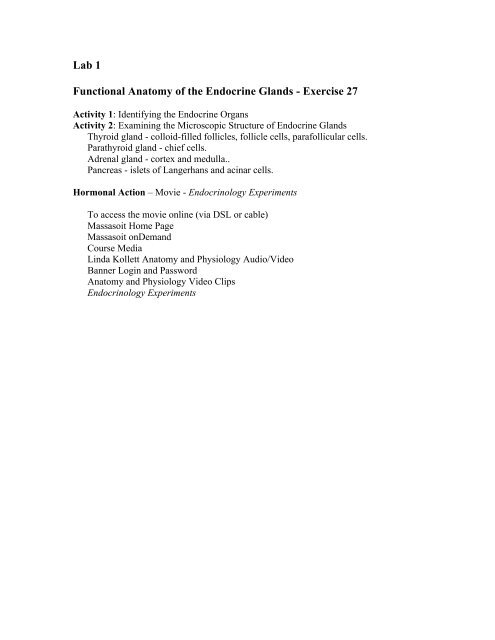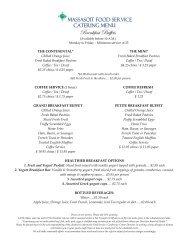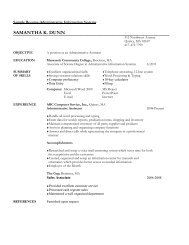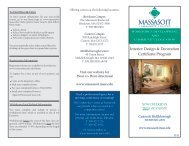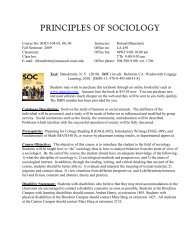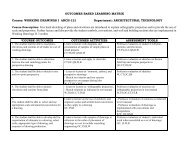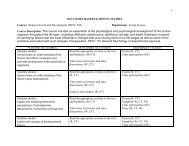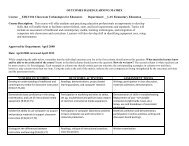Lab 1 Functional Anatomy of the Endocrine Glands - Exercise 27
Lab 1 Functional Anatomy of the Endocrine Glands - Exercise 27
Lab 1 Functional Anatomy of the Endocrine Glands - Exercise 27
Create successful ePaper yourself
Turn your PDF publications into a flip-book with our unique Google optimized e-Paper software.
<strong>Lab</strong> 1<br />
<strong>Functional</strong> <strong>Anatomy</strong> <strong>of</strong> <strong>the</strong> <strong>Endocrine</strong> <strong>Glands</strong> - <strong>Exercise</strong> <strong>27</strong><br />
Activity 1: Identifying <strong>the</strong> <strong>Endocrine</strong> Organs<br />
Activity 2: Examining <strong>the</strong> Microscopic Structure <strong>of</strong> <strong>Endocrine</strong> <strong>Glands</strong><br />
Thyroid gland - colloid-filled follicles, follicle cells, parafollicular cells.<br />
Parathyroid gland - chief cells.<br />
Adrenal gland - cortex and medulla..<br />
Pancreas - islets <strong>of</strong> Langerhans and acinar cells.<br />
Hormonal Action – Movie - Endocrinology Experiments<br />
To access <strong>the</strong> movie online (via DSL or cable)<br />
Massasoit Home Page<br />
Massasoit onDemand<br />
Course Media<br />
Linda Kollett <strong>Anatomy</strong> and Physiology Audio/Video<br />
Banner Login and Password<br />
<strong>Anatomy</strong> and Physiology Video Clips<br />
Endocrinology Experiments
Name____________________________<br />
<strong>Lab</strong> Section ________________<br />
Hormonal Action: Wet <strong>Lab</strong> Movie<br />
Movie - Experiments in Hormonal Action<br />
Answer <strong>the</strong> following questions after watching <strong>the</strong> movie in lab or on Massasoit<br />
onDemand at <strong>the</strong> MCC web site.<br />
1. Pituitary Extract and Frog Ovulation.<br />
a. What are <strong>the</strong> two main hormones <strong>of</strong> interest in <strong>the</strong> frog pituitary extract?<br />
________________ and _______________<br />
b. What is <strong>the</strong> role <strong>of</strong> pituitary extract in <strong>the</strong> frog?<br />
c. What is <strong>the</strong> control frog in <strong>the</strong> experiment?<br />
d. Do <strong>the</strong> data support <strong>the</strong> hypo<strong>the</strong>sis that pituitary extract is necessary for<br />
ovulation? _____<br />
e. Explain your answer.<br />
2. Effects <strong>of</strong> Hyperinsulinism.<br />
a. Describe <strong>the</strong> fish swimming behavior when it is first put in <strong>the</strong> water containing<br />
insulin.<br />
b. Describe <strong>the</strong> fish swimming behavior after swimming in <strong>the</strong> insulin and water for<br />
a few minutes.
c. Where does insulin enter into <strong>the</strong> fish?<br />
d. What does insulin do to blood glucose levels in <strong>the</strong> fish to cause <strong>the</strong> observed<br />
effect?<br />
e. Why does <strong>the</strong> fish go into a coma?<br />
f. Why does <strong>the</strong> fish recover when it is put in a bowl containing glucose and water?<br />
g. Based on this observation, what do you think might happen to a person if <strong>the</strong><br />
blood glucose level falls precipitously (hypoglycemia) and why ?<br />
3. Epinephrine and <strong>the</strong> Heart.<br />
a. What effect did epinephrine have on <strong>the</strong> force <strong>of</strong> heart contraction?<br />
Circle one increase decrease no effect<br />
b. What effect did epinephrine have on <strong>the</strong> rate <strong>of</strong> heart contraction?<br />
c. Circle one increase decrease no effect<br />
d. What gland releases epinephrine as a hormone? Be as specific as you can.
e. What advantage might <strong>the</strong>re be to having <strong>the</strong> heart rate and force <strong>of</strong> cont raction<br />
increase during <strong>the</strong> fight or flight response?<br />
4. Acetylcholine and <strong>the</strong> Heart (ACh is not a hormone in vivo, but this demonstrates <strong>the</strong><br />
effect <strong>of</strong> an ANS neurotransmitter on <strong>the</strong> heart.<br />
a. What effect did ACh have on <strong>the</strong> force <strong>of</strong> contraction?<br />
Circle one increase decrease no effect<br />
b. What effect did ACh have on <strong>the</strong> rate <strong>of</strong> heart contraction?<br />
Circle one increase decrease no effect<br />
c. What branch <strong>of</strong> <strong>the</strong> ANS releases ACh as a postganglionic fiber neurotransmitter?<br />
d. Is <strong>the</strong> effect agonistic or antagonistic to epinephrine?<br />
Circle one agonistic antagonistic
Review Sheet<br />
<strong>Exercise</strong> <strong>27</strong> - <strong>Functional</strong> <strong>Anatomy</strong> <strong>of</strong> <strong>the</strong> <strong>Endocrine</strong> <strong>Glands</strong><br />
1<br />
2<br />
3<br />
4<br />
5<br />
6<br />
7<br />
8<br />
9<br />
10<br />
1. Match <strong>the</strong> labels on <strong>the</strong> figure with <strong>the</strong> terms below<br />
____ Adrenal gland<br />
____ Hypothalamus<br />
____ Ovary<br />
____ Pancreas<br />
____ Parathyroid gland<br />
____ Pineal gland<br />
____ Pituitary gland<br />
____ Testis<br />
____ Thymus<br />
____ Thyroid gland
2. What gland or glands release(s) each <strong>of</strong> <strong>the</strong> following hormones?<br />
______________________ Parathyroid hormone<br />
______________________ Estrogens and progesterone<br />
______________________ Testosterone<br />
______________________ Many releasing hormones (TRH, CRH, GHRH etc.)<br />
______________________ FSH, LH, GH, ACTH, Prolactin, TSH,<br />
______________________ T-cell stimulating hormones<br />
______________________ Melatonin<br />
______________________ Mineralocorticoids, glucocorticoids, androgens, epinephrine<br />
and norepinephrine<br />
______________________ Insulin and glucagons<br />
______________________ Thyroid hormone<br />
3. Define hormone<br />
4. Define target cell<br />
5. Hormones are carried in <strong>the</strong> blood. Why don't all tissues respond to all hormones?
Note: Information from questions 6 – 11 may appear on <strong>the</strong> first lecture exam.<br />
6. Classify each <strong>of</strong> <strong>the</strong> following hormones as steroid or amino acid-based. Indicate<br />
whe<strong>the</strong>r <strong>the</strong> hormone uses <strong>the</strong> second messenger or direct gene activation mechanism <strong>of</strong><br />
action.<br />
Hormone<br />
Thyroid<br />
hormone<br />
Growth<br />
hormone<br />
Insulin<br />
Molecule Type<br />
Amino Steroid<br />
acidbased<br />
Mechanism <strong>of</strong> Action<br />
Direct gene Second<br />
activation messenger<br />
O<strong>the</strong>r<br />
mechanism<br />
Glucagon<br />
Aldosterone<br />
Cortisone<br />
Parathyroid<br />
hormone<br />
Hormones - Matching (8-9)<br />
A Aldosterone<br />
B Cortisol<br />
C Glucagon<br />
D Growth Hormone<br />
E Insulin<br />
F Parathyroid<br />
Hormone<br />
G Thyroid Hormone<br />
7. Target Cells or Tissues - Match <strong>the</strong> hormones and <strong>the</strong> correct target cells.<br />
____ Liver, muscle, bone, cartilage<br />
____ Body cells/gluconeogenesis, fat mobilization, protein metabolism<br />
____ Osteoclasts (stimulates), kidneys, intestine via activated Vitamin D<br />
____ Kidney tubules<br />
____ Body cells/ role in metabolic rate regulation, growth and development<br />
____ Liver<br />
____ Muscle and fat cells, but NOT liver, kidney and brain
8. Stimulus for Release - Match <strong>the</strong> stimulus for release listed below with <strong>the</strong> correct<br />
hormone.<br />
A Aldosterone<br />
B Calcitonin<br />
C Cortisol<br />
D Glucagon<br />
E Growth Hormone<br />
F Insulin<br />
G Parathyroid<br />
Hormone<br />
H Thyroid Hormone<br />
____ Rising levels <strong>of</strong> blood glucose, amino acids and fatty acids<br />
____ Falling levels <strong>of</strong> blood glucose<br />
____ Low sodium, high potassium, renin-angiotensin mechanism<br />
____ ACTH release<br />
____ Low blood calcium levels<br />
____ Increasing levels <strong>of</strong> TSH<br />
____ GHRH release, hypoglycemia, exercise etc.<br />
10. Blood glucose levels are normally maintained from 70-120 mg/dl. Describe <strong>the</strong> role<br />
<strong>of</strong> negative feedback in maintaining homeostasis <strong>of</strong> blood glucose.<br />
6 points


